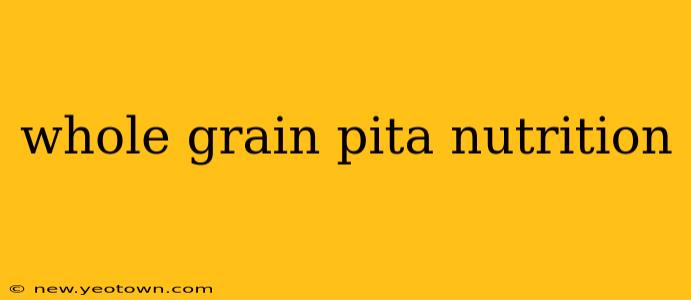The aroma of freshly baked pita bread, warm and slightly chewy, is enough to evoke feelings of comfort and delicious meals. But beyond its delightful taste and versatility, whole grain pita bread offers a surprising nutritional punch. This isn't your average processed flatbread; we're exploring the nutritional powerhouse that is whole grain pita, uncovering its benefits and addressing some common questions.
Imagine yourself biting into a warm pita, its slightly nutty flavor hinting at the wholesome ingredients within. That satisfying chew isn't just texture; it's a testament to the fiber-rich goodness packed into every bite. Let's unravel the nutritional tapestry of whole grain pita and discover why it deserves a prominent place in your healthy eating plan.
What are the nutritional benefits of whole grain pita bread?
Whole grain pita bread boasts a significantly higher nutritional profile than its refined counterparts. The key lies in the "whole grain" aspect. Unlike white pita, which is made from refined flour, whole grain pita retains the entire grain kernel – the bran, germ, and endosperm. This trifecta of goodness contributes to a wealth of nutrients including:
- Fiber: Whole grain pita is an excellent source of dietary fiber, crucial for digestive health. Fiber promotes regularity, helps you feel full longer (great for weight management), and contributes to a healthy gut microbiome.
- Complex Carbohydrates: Unlike simple carbs found in refined grains, the complex carbohydrates in whole grain pita provide sustained energy release, preventing those mid-afternoon energy crashes.
- Vitamins and Minerals: Whole grains are packed with essential vitamins and minerals. Expect to find a decent amount of iron, magnesium, selenium, and various B vitamins in your whole grain pita. These nutrients play vital roles in various bodily functions, from energy production to immune system support.
- Protein: While not a primary protein source, whole grain pita does offer a modest amount of protein, contributing to your daily protein intake.
How does whole grain pita compare to white pita bread?
The difference between whole grain and white pita is substantial. White pita, made from refined flour, undergoes a process that removes much of the bran and germ, stripping away much of the nutritional value. While white pita might be softer and lighter, it lacks the fiber, vitamins, and minerals found in abundance in its whole grain counterpart. Think of it this way: whole grain pita is a nutrient-dense food, while white pita is more of an empty-calorie option.
Is whole grain pita good for weight loss?
The high fiber content in whole grain pita plays a significant role in weight management. Fiber promotes satiety, meaning you feel fuller for longer after eating. This can help you control your portion sizes and reduce overall calorie intake, making it a valuable addition to a weight-loss diet. However, remember that moderation is key; even healthy foods should be consumed as part of a balanced diet.
What are the potential downsides of eating whole grain pita?
While generally healthy, some individuals might experience digestive discomfort when first incorporating whole grain pita into their diet. This is often due to the higher fiber content. Starting with small portions and gradually increasing your intake can help your body adjust. Also, be mindful of the added ingredients; some brands might contain extra sugar or unhealthy fats. Always check the nutrition label before purchasing.
How many calories are in a whole grain pita?
The calorie count of whole grain pita can vary depending on the brand and size. Generally, a single medium-sized whole grain pita contains around 150-200 calories. It's crucial to check the nutrition label for the specific calorie count of your chosen brand.
How can I incorporate whole grain pita into my diet?
Whole grain pita's versatility makes it a fantastic addition to various meals. Use it as a base for healthy wraps filled with veggies, lean protein, and hummus. It's also delicious toasted and served with dips like guacamole or baba ghanoush. You can even use it as a pizza crust for a healthier twist on a classic. The possibilities are endless!
In conclusion, whole grain pita bread offers a delicious and nutritious way to incorporate whole grains into your diet. Its high fiber, complex carbohydrate, and vitamin content make it a valuable asset for maintaining good health and well-being. By making informed choices and selecting brands with minimal added sugars and unhealthy fats, you can enjoy the delicious taste and significant health benefits of this versatile flatbread.

